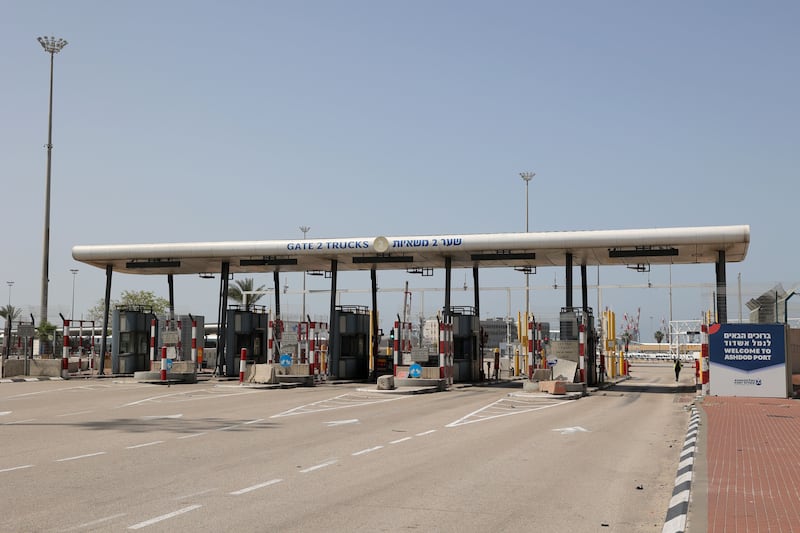Israel has announced it will reopen a key crossing into Gaza and allow more aid through another crossing and a port after a warning from Joe Biden that future US support for Israel will depend on it taking concrete action to protect civilians and aid workers. But will this make a substantial difference for Palestinians in Gaza, where Israel’s war has now killed an estimated 33,000 people and created a humanitarian crisis?
What is the significance of Israel’s announcement that it will reopen land aid routes?
Humanitarian organisations have long said that the most effective way to get urgently needed aid into Gaza, where the population is facing catastrophic levels of hunger, is via land routes. Before the war began with Hamas’s attack on 7th October last year, which killed 1,200 people according to Israeli tallies, up to 500 trucks a day were crossing into Gaza.
The World Food Programme said last month that to meet the most basic needs in Gaza, at least 300 trucks would need to cross daily into the territory. While Jordan, the US and other countries have been airdropping aid, and World Central Kitchen – seven of whose workers were killed by Israel this week – had been distributing supplies, the aid they have been able to deliver has been nowhere near the level needed.
What routes will be opened?
According to an Israeli government statement released on Thursday night, it “will allow the temporary provision of humanitarian aid through Ashdod and Erez crossing and increase Jordanian aid through Kerem Shalom”.
Kerem Shalom, in southern Israel, is a well-established truck crossing, while Erez, in northern Gaza, is the site of the main passenger terminal for entry into the territory from Israel. Use of the port of Ashdod appears to be the most significant. With its established handling and inspection capacity, Ashdod, which lies about 40km north of Gaza, potentially represents the closest and most direct route for large volumes of humanitarian aid to enter.
How quickly can the routes be used?
Although Israel has tried to suggest that the Erez crossing was not viable because of the damage done to it on October 7th, the reality is that Israeli military traffic has been using ad-hoc crossing points where the IDF has taken down sections of the border fence since the beginning of the ground offensive last year.
Any route through Erez leads quickly to Gaza’s paved road system, including the main north-south road, and will provide access to the area of immediate greatest need: northern Gaza, where tens of thousands of people are experiencing famine and subsisting on barely 250 calories a day.
Could Israel have done this sooner?
For weeks Israeli officials tried to claim there was sufficient aid entering Gaza despite repeated accusations by the UN and aid and humanitarian groups that it was actively obstructing the delivery of supplies.
Thursday’s announcement by Israel – after the US’s warning that its support depended on immediate steps being taken to assist Gaza’s civilian population – underscores the fact that Israel could have made this decision sooner but chose not to.
The Israeli cabinet’s decision followed briefings by foreign ministry officials who warned that if the humanitarian aid were not increased, Israel would risk international sanctions and even an arms embargo saying they had received “very clear signals” from their counterparts in the US and in Europe that Israel would face unprecedented sanctions if the aid were not increased immediately.
What are the potential holdups?
Israel has been accused of slow-walking security inspections for trucks already waiting to cross into Gaza, which could continue, but the warning from Washington has been clear. “In the coming hours and days, we will be looking for concrete, tangible steps that they’re taking,” said White House spokesperson John Kirby on Thursday.
Biden’s own language was also unusually precise in suggesting that Israel will be closely watched for concrete compliance.
A readout of Biden’s call with Israel’s prime minister, Binyamin Netanyahu, said the president “made clear the need for Israel to announce and implement a series of specific, concrete and measurable steps to address civilian harm, humanitarian suffering and the safety of aid workers”. The White House summary added: “He made clear that US policy with respect to Gaza will be determined by our assessment of Israel’s immediate action on these steps.”

How will aid be distributed?
International aid agencies are operating inside Gaza and could bring in more personnel. Unrwa, the main UN agency for Palestinian refugees, employs thousands of staff inside Gaza and would be best placed to be involved – although Israel has blocked it from distributing aid in northern Gaza.
The Biden administration has suggested previously that problems of theft and looting of convoys could be addressed by flooding Gaza with aid, dramatically reducing the sense of desperation.
[ Amid Israeli pressure to dismantle it, the Unrwa is indispensable to PalestiniansOpens in new window ]
Does this mean the war is coming to an end?
The US, UN and other governments, including the UK, have made it clear they are deeply unhappy with the very high level of Palestinian civilian deaths in Israel’s campaign. Biden’s reference to the need to mitigate “civilian harm” and protect humanitarian workers suggests that Israel is unlikely be able to continue conducting the war with its current high tolerance for civilian fatalities.
While the Israeli government has suggested that increased aid access will allow it to continue fighting, the US has also made clear that it strongly opposes the plans it has been briefed on for an attack on the southern Gaza city of Rafah, where more than one million people are sheltering, not least Israel’s “unrealistic plans” to evacuate civilians before an assault.
All of which suggests that the space for Israeli operations at the scale that has been witnessed for the past six months is shrinking and with that there is potential for a decrease in violence. – Guardian
- Listen to our Inside Politics Podcast for the latest analysis and chat
- Sign up for push alerts and have the best news, analysis and comment delivered directly to your phone
- Find The Irish Times on WhatsApp and stay up to date













